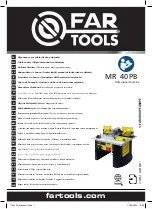
49
Appendix B.
Bridged mode
(
RFC-1483
)
RFC-1483 provides the simplest method of connecting end station over an
ATM network. User data in the form of Ethernet frames is encapsulated into
AAL5-PDU for transport over ATM. RFC-1483 provides no authentication and
configuration such as would be provided by PPP. RFC-1483 implementation
supports VC multiplexing and LLC/SNAP encapsulation in both routed and
bridged configurations.
Classical IP over ATM-IPOA
(
RFC1577
)
User data in the form of IP packets is encapsulated into AAL-5 PDUs for
transport over ATM. The fact that the user data is routed at an IP layer instead
of bridged MAC layer allows the source and destination to be on different
subnets. A notable drawback of IPoA is the lack of authentication and
configuration such as would be provided by PPP.
PPP over ATM-PPPoA
(
RFC-2364
)
The use of PPPoA is similar to IPoA. However, a PPP session is established to
the remote access server (RAS). The PPP packets are encapsulated
according to RFC-2364 for transmission over an ATM link. On the receive side,
the de-encapsulation is performed. The PPP session is terminated and the IP
packets can be delivered to the end user over Ethernet or other medium.
PPP over Ethernet-PPPoE
(
RFC-2516
)
The PPP over Ethernet
(
PPPoE
)
encapsulation is used to transport PPP traffic
from a PC to a DSL device over Ethernet and then over the DSL link using
RFC-1483 encapsulation. There may be multiple PPP sessions, each
terminated in a PC or in the CPE device and in a PPP aggregator on the CO
side.
•
The PPPoE Client terminates PPPoE session within the CPE device, this
configuration enables PPPoE session without a need for additional
software.
•
The PPP traffic for a Relay Agent is not terminated in the DSL device,
rather it is relayed over the DSL link to a PPP aggregator in the CO PPPoE
relay agent determines on which session locally originated PPPoE traffic
belongs. The relay agent forwards that traffic, without any unnecessary
processing to the correct destination only. Similarly, received data is
immediately relayed only to the appropriate client PC. Not only does this
approach enhance performance by eliminating additional process, it also
provides a critical security feature, so it prevents for example corporate
bound data from being exposed to the Internet.

































